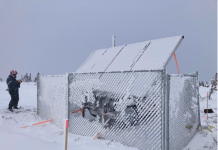WindESCo, a pioneer in improving asset performance and reliability for wind-turbine stakeholders, recently announced the installation of its Swarm technology across Longroad Energy’s Milford I & II wind plants in Utah, featuring a combined capacity of 306 MW. The commissioning of Swarm at Milford marks the wind industry’s first full-scale implementation of commercial wake steering and collective control technology.

Wakes at wind farms create substantial turbulence and curtailment, reducing plant output by up to 20 percent, according to a study published in Wind Energy Science. As wind-energy installments have grown in turbine size and scale over the last several years, this problem has been exacerbated. Wakes are of particular concern to the growing number of offshore wind plants planned around the world, including along the Atlantic and Pacific coasts of the U.S.
Swarm, the industry’s first commercial solution for collective control of wind turbines, works by combining advanced analytics, model-in-the-loop control, and Industrial Internet of Things (IIOT) to accomplish +3 percent increase in annual energy production (AEP) via wake steering and additional collective control applications developed by WindESCo.
Swarm reduces curtailment, optimizes low wind resource, and protects against extreme conditions that have become increasingly common due to climate change, thereby increasing asset life.
The Milford I&II Swarm installation was completed in December 2022 on 165 turbines, consisting of a mix of GE 1.5-MW and Clipper 2.5-MW machines. With both sites operational for more than a decade, WindESCo and Longroad’s collaboration supported the plants’ repowering, which also included rotor, blade, and controller upgrades for many turbines.
“It’s no secret that as assets age they have a natural tendency to experience certain losses in efficiency,” said Jeremy Law, Longroad Energy’s head of asset management. “But that doesn’t have to be the end of the story. We are committed to looking at innovative solutions that not only mitigate production loss, but actually reverse that direction of travel. We selected Swarm at Milford I & II because we are comfortable that WindESCo will deliver that expected AEP gain.”
“While many research teams have modeled and written about the potential for improving wind-plant performance through wake steering, never before has a large-scale commercial test of such technology been completed,” said Mo Dua, WindESCo founder and CEO.
“We are so proud of the years of work that went into bringing this solution to the market. The commissioning of Swarm at Milford demonstrates that large-scale wake steering is possible as a retrofit solution for older assets, while also proving feasibility for Swarm to support the expanding global fleet of wind turbines offshore.”
More info www.windesco.com



























